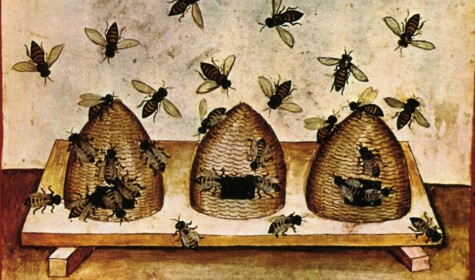Pollinators play an essential role in our food system, with an estimated three quarters of crops depending on them. Yet, due in part to the impacts of intensive farming practices, their numbers are in decline. Here, beekeeper and Chair of the Bee Improvement and Bee Breeders Association, Jo Widdicombe, looks at the issue of genetic diversity and why it is critical to safeguarding the future of one of our key crop pollinators – the honey bee.
In the last 50 years, we have seen a decline in many insect populations including some bumble bee and solitary bee species. In 1992, the varroa mite was found to have reached Britain and the number of honey bee colonies and beekeepers declined rapidly. After a campaign by British Beekeepers Association (BBKA) and others, highlighting the plight of the honey bee, the number of beekeepers and colonies started to rise again. Some have suggested that the increase in honey bee numbers has impacted on other insect species causing a decline through competition, but insect numbers were declining long before honey bee populations started to rise again.
The issue of available forage is an important one for beekeeping, as well as for other pollinating insects, but it is an issue that beekeepers have very little influence over. Intensive farming techniques, the use of chemicals, the loss of habitats and the resulting reduced availability of forage, all impact on insect populations. These are all issues that sustainable agriculture, together with good management of ‘wild spaces’, may be able to address, but beekeepers also need to play their part in developing more sustainable practices.
What do we mean by sustainable beekeeping?
Beekeeping is often described as a partnership between the bee and the beekeeper, and both need to benefit if the system is to be sustainable. Beekeepers have a strong interest in keeping their bees alive and healthy, so will use techniques that they believe will safeguard their stock. As with many enterprises, though, there can be a conflict between short-term economics and long-term sustainability, and what happens in practice may not be beneficial in the long run.
Apart from the local environment and available forage, the most important aspect of a sustainable system is maintaining the qualities of the bees themselves. Just like any other livestock, the characteristics or behaviour of the bees can be assessed, and the good traits selected. We can rear offspring from the healthiest colonies, for example, or from those which are calm, rather than aggressive. Others will choose to breed from their most productive colonies. By rearing offspring from those that perform well under local conditions, we can develop a population that is ‘locally adapted’, rather than the common practice of buying in queens that are genetically programmed to thrive in different environmental and climatic conditions.
The use of hybridisation in the honey bee
In the course of the honey bee’s evolution, about 28 subspecies have developed in Europe, Africa and the Near and Middle East. These are the result of the bees responding to particular environmental and climatic conditions in relative geographic isolation. In the last few hundred years, honey bees have been introduced to most parts of the world. In Northern Europe, including the British Isles, the original subspecies was the dark European honey bee, Apis mellifera mellifera.
In 1859, Britain received its first recorded imports of another subspecies, Apis mellifera ligustica, from Italy. We have continued to import and hybridise the subspecies ever since. In recent years, the level of recorded imports of queens has been in excess of 20,000 per annum including imports of ‘breeder queens’ from which many offspring can be reared.
Hybridisation is a technique which is widely used in animal and plant husbandry. The crossing of different breeds or varieties to produce the benefits of hybrid vigour, can be repeated at will. The hybridisation of honey bee subspecies was a technique pioneered by Brother Adam of Buckfast Abbey. He experimented with crossing different subspecies and the resulting offspring were known as Buckfast Bees. The same technique is still in use today, particularly in Denmark, to produce the Danish Buckfast which is exported around the world.
The problems of hybridisation in honey bees
In the first few weeks of her life, a queen honey bee will fly out from the hive, perhaps two or three times, and mate with numerous drones. This mating, commonly with 10 to 15 drones, will last her a lifetime of egg-laying, around two to three years and sometimes longer. It is a system that helps to maintain genetic diversity in the bee population and reduces the likelihood of inbreeding becoming a problem.
To produce a hybrid strain of bees, such as the Buckfast, isolated mating stations are used or the instrumental insemination of queens. This is to ensure that the queens mate with the selected breed of drones. The offspring of these bees have hybrid vigour and can produce good results. The problem arises in future generations as these colonies produce new queens which mate with numerous drones from the surrounding area. Local bee populations quickly become a random mix of different breeds.
These colonies can have issues of aggressive behaviour, but the biggest problem is that queens reared from these colonies do not breed true. If, for example, one finds an exceptionally good colony and rears some queens from it, the offspring are likely to be extremely variable and not display a close similarity to the parent colony. This makes selection and improvement of bees very difficult and encourages beekeepers to buy further imports in a bid to get a better bee.
Is there an alternative, more sustainable system?
Although beekeeping can be a solitary occupation, bees interact and are affected by other colonies in the area. If someone brings in a queen from the Mediterranean, for example, those genes will soon be in many colonies in the area. The drones that colony produces mate with new queens from local colonies. So, whilst some beekeepers avoid the use of imports, they can still be affected by the issue of random hybridisation, through the mating of their queens with neighbouring drones, possibly up to a six-mile radius.
The way forward is to start thinking about selection and improvement within our local populations, as a whole, instead of thinking that we are beekeeping in isolation and that the random introduction of new queens is the answer. Maintaining genetic diversity within our local populations is very important, but importing genes suited to different climates and environments is not the answer. There is plenty of genetic diversity here already. We should remember that the subspecies are genetically diverse within themselves which is how they have survived over the millennia.
How do we progress from the current position?
Currently, we have a great mixture of bees in this country descended from many different subspecies, and we are continually adding to this through further imports. If we want to refine our population, we should stop importing bees and allow natural selection to go to work. Gradually genes unsuited to bees in this country would drop out through the loss of certain colonies.
Natural selection helps to produce a bee that is a good survivor, but, just as in livestock farming, we are also looking for qualities that the beekeeper wants, such as a docile nature, good productivity, and so on. We can build on what nature selects by assessing colonies for the qualities that we want. We can then choose to select which colonies to rear further queens from. It is a system based on natural and artificial selection (by the beekeeper).
Drones produced by our newly reared queens are produced from unfertilised eggs and are, therefore, direct offspring of our original selected queens. Gradually, the quality of the whole local population can be improved. It is a system that has been shown to produce a locally adapted bee and to improve quality whilst maintaining genetic diversity. This is in contrast to the current system of importing bees to address the constant decline in quality and continuing the vicious circle.
The National Bee Improvement Programme (NatBIP)
The National Bee Improvement Programme has been launched by The Bee Improvement and Bee Breeders Association (BIBBA) in order to place our beekeeping on a sustainable footing where quality can be maintained or improved. Qualification for participation is very simple; the beekeeper merely agrees to avoid the use of imported, or the offspring of recently imported, stock.
It is felt that this is the first step to putting our beekeeping back on track and allowing us to build on nature’s survivors, combining this with what is good for the beekeeper. Although it is described as a national programme, it is built up by local beekeepers working with local bees. Just as the shift to landrace crops and native livestock breeds underpins a more resilient and regenerative farming sector, so prioritising locally adapted bees is essential to securing a stable and sustainable future for beekeeping.
For more information on the National Bee Improvement Programme, including details of how to take part, please visit the BIBBA website.
Featured image available here under the Creative Commons license.



